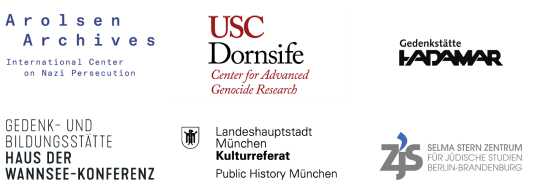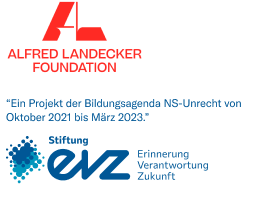Annotations
Cologne
May 1940
The photo shows people with luggage standing in a queue under guard in the inner courtyard of the Cologne exhibition center. They are probably awaiting registration and accommodation, as well as the degrading "delousing" procedure that lies ahead of them.
Annotations
Keywords
4
Historical context
Deportation von Köln nach Platerów im Mai 1940
Beginning in the early morning hours of May 16, 1940, a police raid took place in Cologne. People racially persecuted as Sinti and Roma were arrested in their apartments or in the camp at Venloer Strasse 888, where they were compelled to live. Their possessions were confiscated, and they were taken by truck to the exhibition center in Cologne-Deutz, where they had to undergo a degrading "delousing" procedure and medical examination and wait for several days while other people from the region arrived. They were forcibly subjected to a “racial biological assessment" in the Volkshaus at Severinstrasse 199, and the results decided whether or not they would be deported. On May 21, a freight train with 938 passengers left Cologne-Deutz for occupied Poland and arrived in Platerów on the Belarusian border after a journey lasting three days. The deportees were taken to camps and ghettos to perform forced labor. Many died of starvation, disease, and mistreatment or were murdered in targeted campaigns.
Sources
About the image series
The three photographs have survived as reproductions and show Sinti people who had been arrested arriving at the Cologne-Deutz exhibition center, which had been turned into an assembly camp. They had been told that they were being evacuated to escape the air raids, and that because of this, they should pack the bare necessities and take bedding with them. One of the pictures shows children and adults next to this luggage, another shows people forming a queue under guard in the courtyard of the exhibition center. They had probably just arrived and were waiting to be "deloused" and medically examined. This task was undertaken by student nurses, who pose for a group photo with the staff responsible for guarding the detainees in the third picture. These members of staff include a doctor and two commanding police officers, one in SS uniform and the other in the field uniform of the municipal police.
Photographer
Unknown, Police man
All that is known about the photographer is that he was one of the police officers who was directly involved. He wanted to take a souvenir photograph for himself and the student nurses, as described in the provenance history. He may have worked in the police records department since the people under arrest were processed by the department for the purposes of determining their identity.
Provenance
In 1989, Marielies Herrmann, who had been a 19-year-old nursing student in 1940, recounted that the pictures had been taken by one of the police officers as souvenir photos. He and one of the student nurses had become friends. Subsequently, the student nurse had sent prints to everyone involved, including Herrmann. Survivor and civil rights activist Hildegard Lagrenne spoke publicly on the radio in the 1980s about her experiences, which included the May deportation from Cologne-Deutz. As a result, Herrmann contacted the Central Council of German Sinti and Roma and handed the photos over to Lagrenne. They were shown for the first time in the Cologne exhibition marking the 50th anniversary of the deportation. In addition, reproductions of the photos were added to the holdings of the NS-Documentation Center of the City of Cologne and the Documentation and Cultural Center of German Sinti and Roma in Heidelberg in the 1990s.
Call number at source archive
Title at source archive
Acknowledgements
The information published here is based on regional studies carried out in Cologne that constitute groundbreaking research into the history of the genocide of Sinti and Roma. We would also like to thank Dr. Karola Fings, Dr. Frank Reuter, André Raatzsch, Jan Kreutz, and Nina Matuszewski for their extensive support of the project.
Text and research by Malte Grünkorn.
Kooperationsverbund #LastSeen. Bilder der NS-Deportationen Dr. Alina Bothe Projektleiterin
c/o Selma Stern Zentrum für Jüdische Studien Berlin-Brandenburg
Freie Universität Berlin
Habelschwerdter Allee 34A
14195 Berlin
lastseen@zedat.fu-berlin.de
Ein Kooperationsprojekt von

Gefördert durch

Datenschutz | Impressum